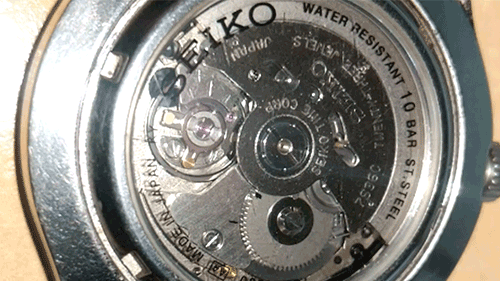Mechanical watch
Do you wear a watch? The answer is probably no, but if you do, you’re probably of an, ahem, more experienced generation, or your watch has the computing power of a 2010-era iPhone. However, I wear a watch, I’m a millennial, and my watch has zero ability to do any sort of computations.
I love my mechanical watch.

The beating heart of my mechanical watch. Also the first animated GIF I’ve ever had on this blog.
Every once in a great while I encounter somebody else with a mechanical watch. For those in the know, it’s possible to immediately identify such watches, so long as they have a second hand. Whereas quartz watches have a second hand that ticks once per second — tick….tick…tick… — mechanical watches beat at least four times per second — ticktickticktickticktick — so the second hand assumes a smooth “sweep” motion from afar. There are exceptions, notably the tuning-fork-driven Accutron, but if you see a real, working Accutron on somebody’s wrist, ask the person about it, because I can guarantee it will make their day.
Mechanical watches are, in every objective sense, terrible timepieces. They stop if you don’t wear them for a few days, they’re nowhere near as accurate as quartz watches even if you do wear them religiously, they require periodic maintenance, and they’ll break if you subject them to even moderate physical insult. So why bother? Because they’re amazing.
They are purely mechanical systems, reliant only on Newtonian physics, that can do something remarkable: keep time, and (usually) recharge themselves. You can the movement doing its thing through the skeleton back present on many mechanical watches, so there is no mystery to it — except for how the designers came up with the ideas, how the machinists/robots produced such precise parts, and, for automatic watches at least, how the whole thing manages to run solely on the tiny bit of energy harvested from the mundane routine movement of one’s arm. It’s all observable, it’s all knowable, and yet it’s magical.
Many high-end watches are still mechanical. Brands like Rolex, TAG Heuer, Breitling, and others more expensive and obscure feature purely mechanical movements as options if not defaults in their pieces. I, on the other hand, have worn a simple Seiko 5 Sports automatic since 2015. It’s not as fancy as the watch it replaced — the crystal is some sort of glass instead of sapphire, the body is stainless steel instead of titanium, and so on — but unlike that other watch, it’s mechanical! My Seiko has been reliable, but it’s cheap enough that if I were to break it I’d simply get a new one. I’ve seen another person wearing a Seiko 5 Sports only once, at an automobile race track several years ago. We exchanged knowing acknowledgements.
Even today, I’ll sometimes take the watch off my wrist and put it next to my ear, just to listen to the “tickticktick” of the balance wheel at the heart of the movement. I’ll flip it over and watch its rhythmic motion beat away the moments. And then I’ll return it to my arm and employ it in its utilitarian raison d’être, using it as my go-to source of time and date information. Some pull out their phones all the time; I save time by telling it from my mechanical wristwatch.
Recent Comments